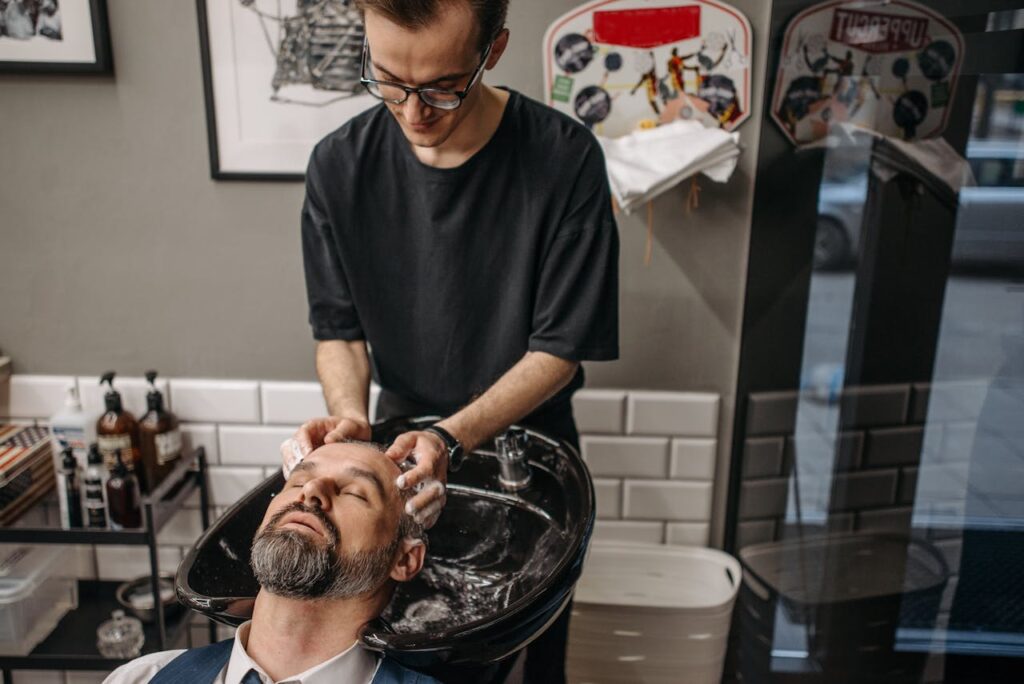For many men, scalp health is a silent battleground. Dandruff flakes raining down on your shoulders, a persistent itch that disrupts your day, and stubborn hair loss can take a toll on your confidence. While genetics play a role, a crucial weapon in your fight for a healthy scalp might be hiding in your shower: the scalp brush.
What is a Scalp Brush and Why Should You Use One?
A scalp brush, also known as a scalp scrubber or shampoo brush, is a handheld tool designed to cleanse and invigorate your scalp. Unlike your fingers alone, a scalp brush offers several advantages:
- Exfoliation: Our scalps, just like the skin on our faces, are prone to a buildup of dead skin cells. This buildup can trap dirt, oil, and styling products, creating an environment ripe for dandruff and itchiness. Bristles on a scalp brush gently buff away these dead skin cells, promoting a clean and healthy scalp environment. This can be especially helpful for those prone to dandruff, a condition characterized by excessive shedding of scalp skin cells.
- Deeper Cleanse: Let’s face it, our fingers can only do so much. A scalp brush reaches areas your fingers might miss, particularly around the hairline and the back of the head. This ensures a more thorough shampoo application, removing not only dead skin cells but also dirt, oil, and styling product buildup. A clean scalp is less likely to experience irritation and itchiness and can promote a healthier environment for hair growth.
- Scalp Massage: The act of brushing your scalp stimulates blood circulation. Increased blood flow brings essential nutrients and oxygen to the hair follicles, promoting hair growth and overall scalp health. A scalp massage with a brush can also be a relaxing experience, helping to ease tension headaches and promote a sense of well-being.
- Thicker, Fuller Hair: As mentioned earlier, increased blood circulation from scalp massages can nourish hair follicles. Nourished follicles are better equipped to produce healthy hair, potentially contributing to thicker, fuller hair growth. While scalp brushes won’t magically reverse male pattern baldness, they can be a valuable tool in your hair care regimen for promoting a healthy scalp environment that supports hair growth.
Benefits of Scalp Brushes for Men
Men are particularly susceptible to scalp issues like dandruff and hair loss. Here’s how a scalp brush can be a game-changer in your hair care routine:
- Combat Dandruff: As discussed previously, scalp brushes excel at removing dead skin cells, a key factor in dandruff control. Regular scalp scrubs with a brush can help loosen and remove dandruff flakes, reducing their visibility and calming an itchy scalp. By promoting a clean scalp environment, scalp brushes can help prevent future dandruff flare-ups.
- Promote Hair Growth: Hair loss is a concern for many men. By stimulating blood flow and removing buildup that can clog follicles, scalp brushes can create a more favourable environment for hair growth. Increased blood flow delivers essential nutrients to the follicles while removing buildup ensures they aren’t blocked and can function optimally. Remember, scalp brushes won’t sprout new hair follicles overnight, but they can be a valuable tool in supporting a healthy scalp that promotes hair growth.
- Reduce Hair Loss: While scalp brushes won’t magically reverse male pattern baldness, a healthy scalp can promote stronger hair and potentially slow down hair loss. Hair loss due to clogged follicles or a poor scalp environment may be addressed with regular scalp scrubs. A healthy scalp provides a foundation for strong hair growth, and scalp brushes can help create this foundation.
- Improve Scalp Health: Overall, scalp brushes can contribute to a healthier scalp environment. By removing dead skin cells, cleansing thoroughly, and stimulating blood circulation, scalp brushes can promote a clean, itch-free scalp that’s less prone to irritation and flaking. A healthy scalp is the foundation for healthy hair growth, and scalp brushes can be a valuable tool in achieving this.
- Relaxation: Let’s not forget the mental benefits! A scalp massage with a brush can be a de-stressing experience. The act of massaging the scalp can promote relaxation and reduce tension headaches. Taking a few minutes during your shower routine to give yourself a scalp massage with a brush can be a great way to unwind and de-stress after a long day.
Choosing the Right Scalp Brush for You
With a variety of scalp brushes available, here are some factors to consider when making your choice to ensure you get the most out of your scalp care routine:
- Bristle Material: The material of the bristles plays a key role in the effectiveness and comfort of your scalp brush. Look for soft or medium bristles made from natural materials like boar bristles or silicone. These materials will effectively cleanse your scalp without irritating it. Boar bristles, in particular, are known to mimic the texture of human hair, reducing tangles and promoting a smoother scalp experience. Avoid brushes with harsh or sharp bristles, as these can scratch your scalp and cause irritation.
- Brush Design: Scalp brushes come in a variety of shapes and sizes. Choose a brush that fits comfortably in your hand and has a design that allows you to easily reach all areas of your scalp. Some brushes have ergonomic handles that provide a secure grip, while others have bendable heads for better control and access to hard-to-reach areas like the back of the head. Consider your grip preference and the areas you find most difficult to reach when selecting a brush design.
- Scalp Sensitivity: If you have a sensitive scalp, opt for a brush with softer bristles and a gentler design. Look for brushes with silicone tips on the bristles, which can provide a more cushioned feel. It’s also important to avoid applying excessive pressure during use. A gentle massage is key to reaping the benefits of a scalp brush without irritation.
How to Use a Scalp Brush Effectively
Now that you’ve chosen the perfect scalp brush, here’s a step-by-step guide to incorporating it into your hair care routine for maximum benefit:
- Prep Work: Before diving in, ensure your hair is thoroughly wet with warm water. Warm water helps loosen dirt, oil, and styling products, making them easier to remove during the cleansing process.
- Lather Up: Apply your regular shampoo to your scalp or directly onto the brush. If you choose to apply shampoo directly to the brush, start with a moderate amount and adjust as needed based on your hair type and lather preference.
- Massage It In: Gently massage your scalp in circular motions with the brush, applying light to moderate pressure. Focus on all areas of your scalp, including the hairline, crown, and sides. Spend some extra time on areas prone to dandruff or itchiness, but avoid scrubbing harshly. The goal is to stimulate circulation and cleanse, not to scrub raw skin.
- Timing is Key: Aim for a scalp massage of 2-3 minutes. This is enough time to effectively cleanse your scalp and reap the benefits of increased blood flow without overstimulating the scalp.
- Rinse Well: Once you’ve finished massaging your scalp, thoroughly rinse your hair to remove all shampoo residue and loosened scalp debris. Leaving behind shampoo residue can clog follicles and irritate the scalp.
- Condition as Usual: Follow up with your regular conditioner to replenish moisture and promote healthy hair. A scalp brush can help remove natural oils along with buildup, so conditioning is an important step to maintain hair health.
Additional Tips for Scalp Health
While a scalp brush can be a valuable tool, a holistic approach is key to achieving and maintaining a healthy scalp. Here are some additional tips to consider alongside incorporating a scalp brush into your routine:
- Scalp-Soothing Ingredients: Look for shampoos and conditioners formulated with scalp-soothing ingredients like aloe vera, oatmeal, or tea tree oil. These ingredients can help calm irritation, reduce itchiness, and promote a healthy scalp environment.
- Scalp Masks: Consider incorporating a scalp mask once a week, especially if you suffer from dandruff or a dry, itchy scalp. Scalp masks are similar to facial masks, offering a concentrated dose of beneficial ingredients to deeply cleanse and nourish the scalp.
- Scalp Massage (without Brush): Even without a brush, you can benefit from a gentle scalp massage during shampooing. Use your fingertips to massage your scalp in circular motions, focusing on areas prone to problems. This can help stimulate blood flow and promote relaxation.
- Stress Management: Chronic stress can exacerbate scalp conditions like dandruff and psoriasis. Practice stress-reduction techniques like yoga, meditation, or deep breathing exercises to manage stress and promote overall well-being, which can positively impact your scalp health.
- Diet and Hydration: A balanced diet rich in essential vitamins, minerals, and omega-3 fatty acids is crucial for overall hair and scalp health. Ensure you’re getting enough protein, iron, zinc, and biotin, which all play a role in hair growth and scalp health. Staying hydrated is also important, as dehydration can contribute to a dry, flaky scalp. Drink plenty of water throughout the day to keep your scalp and body functioning optimally.
- Consult a Dermatologist: If you have severe dandruff, persistent scalp itchiness, hair loss beyond normal shedding, or any other concerns about scalp health, consult a dermatologist. A dermatologist can diagnose the underlying cause of your scalp problems and recommend the most effective treatment plan
Scalp Brush Bonus Round: Advanced Techniques and DIY Options
While the basic scalp brush routine is effective, there are ways to elevate your scalp care game. Here’s a look at some advanced techniques and even a DIY option for the crafty scalp enthusiast.
Advanced Techniques:
- Double Cleanse: For those with particularly oily scalps or heavy styling product buildup, consider a double cleanse with your scalp brush. Do a first cleanse with a clarifying shampoo to remove excess oil and product build-up. Follow with your regular shampoo and scalp massage for a deeper clean.
- Exfoliating Scalp Scrub: If you’re looking for a more intense exfoliation, you can create a DIY scalp scrub to use with your brush. Mix equal parts brown sugar and olive oil to create a gentle scrub. Apply directly to the scalp and massage gently with the brush before rinsing thoroughly. Important Note: Avoid using harsh ingredients like salt or coffee grounds, as these can irritate the scalp.
DIY Scalp Massager:
For the budget-minded or the DIY enthusiast, here’s how to create your own scalp massager:
- Craft Stick Massager: Take a wooden craft stick and secure a small, soft washcloth to one end with a rubber band. Use this DIY tool to gently massage your scalp in circular motions during shampooing.
- Silicone Fingertips: Another option is to use silicone fingertip covers, often used for gripping hot objects in the kitchen. These provide a gentle, textured surface for massaging your scalp during shampooing.
Remember:
- Regardless of the technique you choose, be gentle with your scalp. Avoid harsh scrubbing or excessive pressure.
- Pay attention to your scalp’s needs. If you experience any irritation, adjust your technique or frequency of use.
- Consistency is key! Regular use of a scalp brush, along with a healthy lifestyle and proper hair care routine, will contribute to a healthier scalp and potentially promote thicker, fuller hair growth.
By incorporating these tips and exploring different techniques, you can unlock the full potential of scalp brushes and achieve a clean, healthy, and invigorated scalp.



